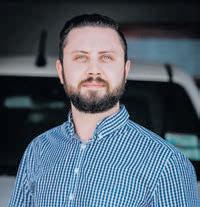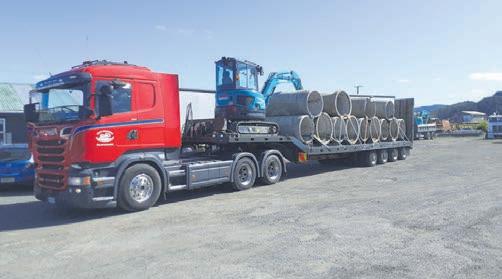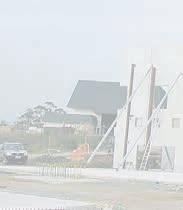tradition alive











































times brought about by the
response to Covid-19 showed very clearly that when every other export


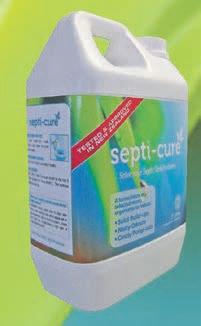

was shut down, the primary sector
on delivering.
The recent schemozzle of government freshwater regulations is an excellent case study to highlight three important lessons.

First, what appears straightforward at a distance (namely from Wellington) isn’t clear-cut on the ground. While the view from the Beehive window might seem to indicate that policymakers know what a ‘wetland’ is, out on the farm, reality can be much more complex.
Federated Farmers’ representative Paul Melville has pointed out recently in the media that, technically, the foreshore is a wetland under regulations set down by the government. That leads to the absurd conclusion that a sandcastle on the beach could be considered a wetland structure requiring resource consent.
Second, everyone doing business needs as much certainty and continuity as possible. Obviously, change must come where there’s a strong need for the status quo to go. Moreover, changes to the law of the land should be minimised when each




new version of regulations tilts the playing field in a new direction.
Thousands of farmers across New Zealand found themselves in technical breach of new fertiliser cap rules because a website wasn’t ready in time for them to comply.





Then you have the situation of endless rounds of consultation. As I write, we are staring down the barrel of a sixth change to the freshwater regulations in just two years. Citizens can’t comply with the law if they don’t know what it is, with constant change making that a closed book to everyone but a handful in certain government agencies.
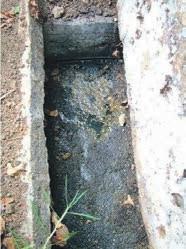


The third and final point is about the importance of focussing on outcome over detail. Wellington should set standards that those living on the land can meet in a variety of different ways. There’s no point prescribing to a level that sees absurdities like weed clearance requiring resource consent.

Writing to the regional council a couple of weeks prior will only slow down something that is actively positive for the environment.
In summary, I’ll keep telling Wellington to allow the farmers in my area to do what they do best: farming. We all need that.
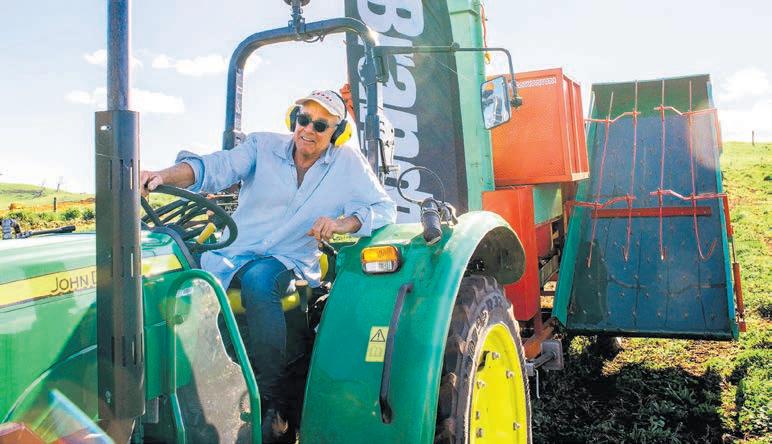
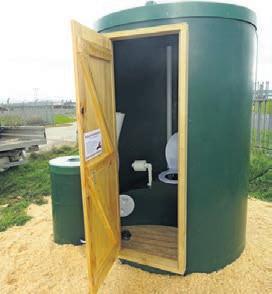

 by Paul Campbell
by Paul Campbell
Peanuts harvested this year from Northland trial sites have been processed into product, and proved to be the equal to what is produced
from overseas as planting gets underway for an expanded third trial in the million-dollar project.
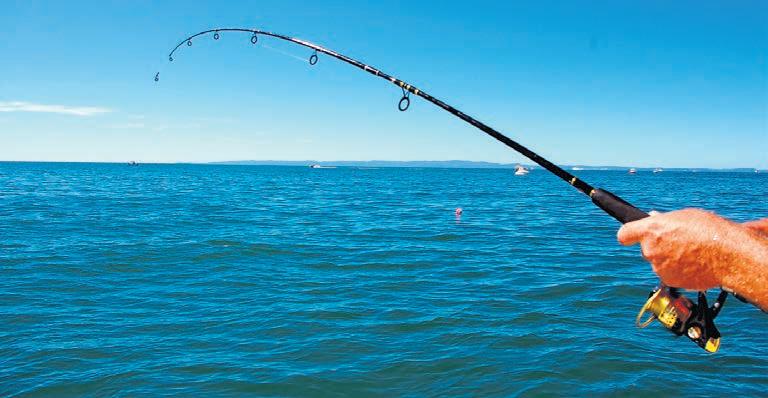


“Nutritional values and oil content in some areas were above international benchmarks. In some cases, even when not higher, they are comparable with equivalent dietary significance,” said Pic’s Peanut Butter owner and trial founder Pic Picot.
“Planting for this year’s season is well underway, with the project increasing from five to eight sites across Te Tai Tokerau, increasing land area from one hectare to four hectares. All sites have been secured with our landowner partners Te Roroa, Upson Downs, Ngai Takoto, Greenhill Farm, Te Rarawa, Te Aupouri, Te Uri o Hau and Simpson Gardens.”


The peanut trial continues to generate conversation and interest from a variety of parties across the country who are following the project with keen interest. In addition, nuts as vIable crops in New Zealand have been expanded with trials in Hawke’s Bay aimed at finding if almonds could be produced commercially in its lower winter temperatures.
Mr Picot said his staff at Pic’s Peanut Butter World, based in Nelson, were “dead keen to source our nuts within New Zealand and in 2020, we teamed up with some amazing people from Northland Inc, MPI’s Sustainable Food and Fibre Futures fund, Plant and Food Research and Manaaki Whenua Landcare Research.”
Fast forward, and Pic is quietly confident that it’s a step in the right direction towards a fully homegrown peanut butter for the future. “We are one of the few
producers in New Zealand that freshly roasts our own peanuts, so to be able to source them from our own backyard would be the cherry on top. Not to mention the huge positive impact it would have in reducing our carbon footprint. If we can pull this off and produce enough peanuts from Kiwi soil, it’d make our peanut butter just that much peanut-better.
“Now the harvest is complete, the nuts have been tested for taste and quality, processed in the Food Factory, and the ultimate proof is contained inside 50 195g jars. Overall, it was a success, with four separate trial batches of home-grown peanuts being blanched, roasted, and put through a grinder to make jars of Crunchy No Salt Peanut Butter.
“One of the batches resulted in a peanut butter very similar in taste to the product we make with our current supply of Hi Oleic Australian and Brazilian peanuts. We’re really looking forward to the next harvest, where we hope to have enough peanuts to process them at Peanut Butter World using our commercial-size roaster and equipment, as we know this will create an end product that’s even closer to the Pic’s red star standard.”
The trust is calling for people to join the team of AgFacilitators, a critical part of support services provided to rural communities in the North of Auckland through to Cape Reinga as they face both individual challenges and extreme climatic events.
“My husband Troy and I contract milk 820 cows west of Whangārei in a split calving system,” said Michelle.



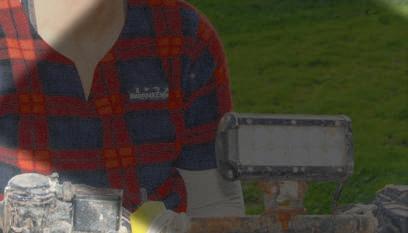




“I was a city girl and am an occupational therapist by trade. I met Troy, who grew up on a beef and sheep farm in the Mangakahia Valley, and when we started our family, I put my career aside to learn how to farm.



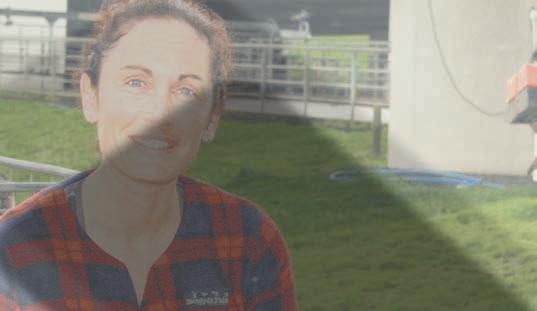
“I love the lifestyle of farming, living off the land and with the animals as well, as the opportunities farming gives our family. It is something you live and breathe. The lifestyle is multifaceted as
you care for your animals, people and land. Those things together can create a thriving business.
“I became a Rural Support Trust AgFacilitator to help support the community I was living in with my occupational therapist skills and ag knowledge. I enjoyed helping people through tough times by giving them extra tools for when things get hard or out of rhythm. Rural Support Trust is our own people helping our own communities.
“AgFacilitators are the people the trust contracts to help others navigate what can seem overwhelming and support them in developing their own solutions. They walk the talk, know the region like the back of their hand, where to reach out, what expertise might be needed and genuinely want to see the people in our communities thrive.
Michelle and her husband Troy are currently contract milking 820 cows
“The trust places a lot of importance on training AgFacilitators, so they are prepared with the knowledge they need, from mental health and wellbeing
to understanding the boundaries of the role, to uncovering knowledge gaps and sourcing the information or support required.
Life is bustling and vibrant for the new residents at our first Northland village, Summerset Mount Denby. Once complete, the village will o er 290 stunning homes to choose from, including villas, cottages and serviced apartments.

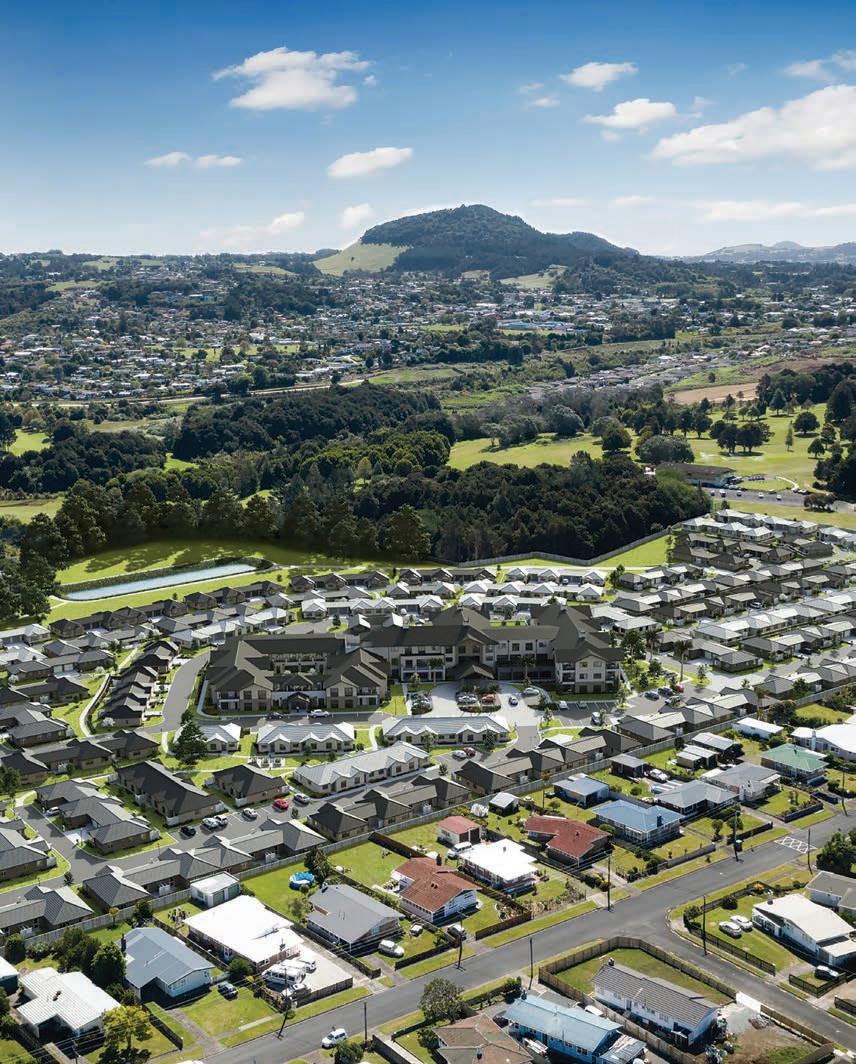
Located next door to Whangarei Golf Club, and just 200m from local shops and amenities, the village will o er resort-style facilities and help on hand if you need it. Our care centre will provide rest home and hospitallevel care, and our state-of-the-art memory care centre will o er safe, apartment-style living for people with dementia.
Our Stage Three release is now pre-selling and going fast, so you’ll need to be quick to secure your first choice!* Call our friendly sales team or drop into our onsite sales o ice today.
Summerset Mount Denby, 7 Par Lane, Tikipunga Call Wendy on 09 470 0282 or 021 246 5086
For the latest information on visiting our villages please call the sales manager
occupy.
visit












The current chair of the Northland Rural Support Trust, Michelle Ruddell, began her commitment to the trust as an AgFacilitator to work directly with communities in need.
“People reach out to us when they just don’t know what to do. They might be bogged down in day-to-day work and don’t know what to do with the difficulties they are facing or where to turn next. AgFacilitators can use their networks to draw on rural expertise and advice, connect someone in need with the appropriate help or just help them see the wood for the trees by sharing their worries out loud.
“There is no one size fits all for being a facilitator. People’s needs can be complex or simple. It may take a simple phone call or one-off visit or a little more time to provide a range of options for that person to draw from. Facilitators need to ensure they know their own boundaries too, and put them in place both to support
their own wellbeing and safety as well as respecting those who reach out.

“I put my hand up because I wanted to support people through tough times. If that is your mantra, then making the time is easy because you are committed to helping people get through so they have someone to unload to as they try to make sense of what’s going on. You are there for them when you can be, with the information they need for the best outcome.
“You are not on your own as an AgFacilitator. You are given the skills and training needed to undertake the role and manage our availability to ensure our clients get the best service possible. We have peer supervision in place, as it’s really important we can debrief in a safe place.
“If you are well-networked in the rural communities of the Far North, Dargaville and surrounds, or in the northwest of Auckland, you could be a great candidate for the service.
A good AgFacilitator has probably got rural and farming experience and an idea of rural support, professionals and advice services.





“In some ways, it is the next step up from having a cuppa with your neighbour when you know they need a friend. The personal rewards are big and I know I help make a positive difference in someone’s life or business.
“We are currently seeking a highly organised coordinator who recognises when rural people need assistance to coordinate an appropriate response. If you are interested, please email michelle. ruddell@ruralsupport.org.nz.
“I know the people I have helped were comfortable carrying on when I stepped out. They had more tools in their toolbox than before and were feeling more positive. Building resilient rural communities start at our front door, and I am proud to be part of that.”
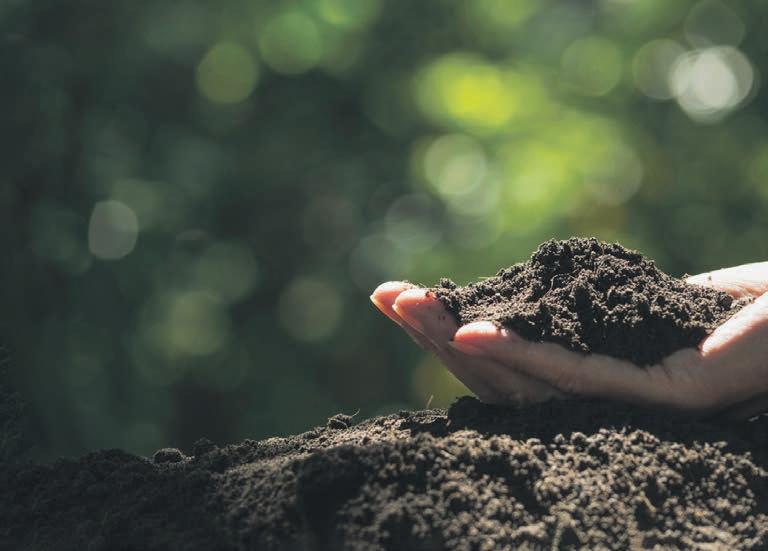











ucas is from New Zealand and had a farming job for seven years, and I was backpacking for a gap year from university,” says Megyn.
met in the middle of nowhere, in the outback at the horse races, and we haven’t been apart since. We came back two years ago for his sister’s birthday
the last flight from Australia
Zealand before the first Covid lockdown, and I got stuck here.”

Lucas grew up on a sheep and beef farm in Fielding and has always been involved in growing plants and trees.
New

“Since we couldn’t return to Australia, we began doing farm work for others and then worked for a contractor planting trees and learned the ropes of how it works

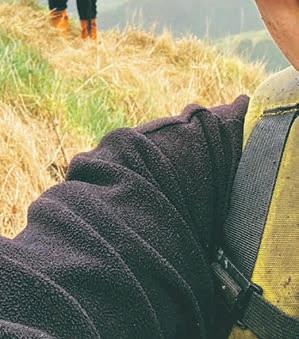

before moving to private contracting. We love being self-sufficient and stay on-site in our caravan when we can to get the project done as soon as possible.


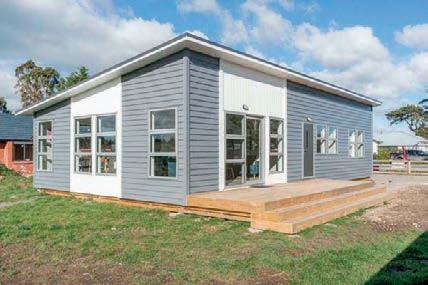



“We mostly do native riparian planting of wetlands, pre-forestation and exotic hardwood for timber, including eucalyptus and sometimes pines.

“This year, we started our own nursery and are growing 100,000 natives, and we also source trees from other nurseries for our clients, or people can supply their own trees.
“We stake exotic trees such as Canadian maple or oaks and fertilise them if necessary, but we don’t do any spraying. Our biggest job has been 15,000 trees, but we go up to 50,000 for early season planting to ensure the trees go in the ground when it is still winter, so they have a chance to get their roots established because if it is too dry — they will just die.
“Most of our clients spot spray for each tree, which helps keep weeds down for the first year. We use large spades to get a big wide hole and try to cultivate 50 per cent


deeper for the roots to establish. We use a fertiliser tablet to give them a bit of help for the first two years, and we try to make sure they stand up nice and straight.
“Stamping the tree properly, so the ground doesn’t open up and dry out helps the tree to get established, and we try to ensure the client chooses the correct plants for the area we are planting. We want to also encourage diversity in the ecosystem for riparian plants too, so everything will grow.”
Lucas says it generally takes a tree approximately three months to establish its root system.
“That’s when you will know how many you may have to replace. Bare root trees have a higher mortality rate, so plants and root trainers are the better option.”
Megyn says she is enjoying indulging in the New Zealand culture and loves the native tree planting, knowing she is giving back to the country.

“It is nice being out in nature, and our clients have been amazingly welcoming. We love having dinner with them, and some bring us bacon and egg pie on the job.

“Luca’s farming background has definitely helped, and he has a Diploma in Horticulture that he did during lockdown. It has given us a great knowledge base of what trees grow where.
“We also do a lot of riparian planting and encourage people to plant trees and shelterbelts to give stock shelter. We like jobs with 1,000 trees minimum and spread excess trees around the farm. If we are in an area, we do small jobs for others if required. People can find us on our Kiwican Contracting Ltd Facebook page.
“Our goal is to plant 1,500 trees a day between the two of us. It is nice working for ourselves because we don’t have to race each other for quotas like contract workers who get paid per tree. We also take our time and plant everything properly and do special requests like maples on one side of the farm and oak on another.
“We particularly love natives or anything permanent. I like exotics as a generational project because you can plant them for your children, and in 35 years, they can mill them to build their houses.”



Northland office 0800 957 7463 (0800 WJPRIME) office.willow-jean.prime@parliament.govt.nz 77 Gillies Street, Kawakawa PO Box 237, Kawakawa 0210








Labour list MP based in Kaipara ki Mahurangi

For appointments and assistance please phone: 0800 582 325 (0800 LUBECK) marja.lubeck@parliament.govt.nz 62-64 Queen Street, Warkworth



 BY ANN VAN ENGELEN AND VERENA PSCHORN
BY ANN VAN ENGELEN AND VERENA PSCHORN



The Northern Wairoa Agricultural & Pastoral Association is heading into its 129th year, with the next A&P Show coming up on Saturday, February 11 2023.






The community in Northern Wairoa will gather for their annual familyoriented celebration of rural life, and they are looking for volunteers to support the event. Richard Alspach, president of the Northern Wairoa Agricultural & Pastoral Association, has been a farmer for most of his life.






“I have spent the best part of the last 50 years representing and advocating on behalf of rural communities,” he says.
“A&P Shows are a reflection of our communities, and without volunteers, there wouldn’t be any shows. Volunteering at the Arapohue A&P Show means becoming part of our rural community. The different A&P shows reflect our values and what is important to us as a community.
“They are a history lesson, a celebration of the community in which they reside, a harvest festival, and they can be a training


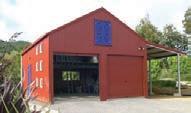
and networking ground. Arapohue is still a very traditional show, but the shows do change with the community they are in.
“When you went into an A&P show 40 years ago, you had a long line of purebred




cattle — it was a beautiful sight. Dairy cows used to be a very big part of the pedigree section, but it has dropped off significantly. The dairy farms that are left are large, and they don’t tend to focus on pedigree cattle.”

Arapohue’s pedigree section is now more attractive for lifestylers with purebred livestock.









“The shearing section has seen its fair share of change as well. In the last few years, the number of shearers has dropped off, and the A&P Association had to find ways to get them back. Nearly 30 per cent of shearers are now women. If you have never been to a show, go to one that has shearing, it is a supreme sport to watch. One of the guys last year could do up to 600 sheep a day.
“Arapohue has a big horse section, too. Horse shows are still well supported because a lot of people with lifestyle blocks get horses and are interested in jumping or displaying

them. We don’t have races in Dargaville anymore, so the show is a good chance to see these beautiful animals in action.
“The indoor sections are a history lesson in itself and go way back before the second world war. They started when we didn’t have supermarkets. If you didn’t preserve your own food, you didn’t have food. If you couldn’t do needlework, you didn’t have trousers. The section has expanded to reflect the community from within; for example, the art section is much bigger now than it was before.
“One of the lessons that came out of Covid was that you don’t need to buy a whole lot of things, and there is now a huge interest in growing your own food. Even if you




don’t grow your own vegetables, get some produce and preserve it and enter one of the competitions. It’s just fun to have a go.
“The need for volunteers to support the shows is huge. Some volunteers just turn up and help with whatever is needed, including setting up, cleaning up and directing the cars. We are particularly looking for stewards, especially for the horse and beef section. They support the judges, record competition outcomes, offer hands-on help at the horse jumps and more.
“They go through training, and a more experienced steward will take them under their wing. We would be delighted to have someone ring us and ask if we need help with that. You just need the right attitude — there is no experience necessary.
“My former next-door neighbours were a Muslim family, and the daughters were interested in becoming stewards in the beef section. So we trained them, and they had a lot of fun. Ideally, the stewards stay with us and come back each year for the next show.
“Throughout the year, there is always a need to maintain fences and buildings, painting horse jumps and helping with the general tidy-up and upgrades to the hall. There is certainly no shortage of things to do.






“Volunteers help out for different reasons. It’s very important for us that they feel welcome. We always put on a get-together after a working bee where everyone can socialise and unwind.”
To volunteer, visit the Volunteering Northland Facebook page, go to volunteeringnorthland.nz or phone 09 945 4984.























Flowering, pollination, and fruit set are underway in avocado orchards: this is the most important stage of growth.
The ower-to-fruit ratio is very low in avocados. A mature tree produces more than one million owers with fruit set only ranging from 0.30.5%. A regular pruning programme ensures adequate light into the canopy, resulting in owers and fruit throughout the canopy. Pruning results in better bud quality. By pruning, you are ower pruning before the tree expends the energy producing the owers. Avocado orchards are now currently in the peak of owering; by then, growers have worked through their pre- owering checklist.

Pushing spring flush with the appropriate nutrient applications during winter, harvesting some or all of the crop, completing any pruning, correcting nutrient imbalances, and having beehives present from 5–10% owering are some ways to set the orchard up for optimal fruit set before full owering hits. Now, the focus is on supporting the tree through very high nutrient demand and withdrawal due to the development of owers and nectar. In many cases, the existing crop is still hanging on the tree.
Growers can optimise fertilisation and fruit set by applying foliar fertiliser and ower sprays of speci c nutrients. Boron and zinc are important nutrients at this time. If you are not regularly applying foliars, ensure you time at least one boron, zinc and seaweed foliar spray when 50% of the trees are at 50% cauli ower stage, 25% at earlier ower development, and 25% approaching full bloom. Apply foliar spray products high in amino acids to support any heavy owering or stressed trees.
Depending on orchard density and flowering intensity, we recommend beehives 8–12 a hectare. For fruit to set have pollen moved on to the owers and lots of it. Encourage your bees to stay busy pollinating owers with a safe source of water nearby. If, during pollination, the weather conditions are not favourable for bee activity, consider applying a pheromone spray.
Soil moisture needs to be managed during fruit set; water stress can cause higher fruitlet drop. With irrigation, use moisture meters to ensure you are applying the required amount of water through dry periods.
I recently spoke with a client I have been helping with painful knee Osteoarthritis (OA) for nearly two years.
When we rst spoke, he needed strong pain relief just to walk for exercise. We agreed that pain medication use would be a good measure of his progress. After six months, he said the pain had completely gone, and no longer needed pain medication. Now a year later, he is still pain-free.
Any successful programme to improve joints affected by OA should address the underlying disease process. OA is a disease that is characterised by cartilage loss due to both mechanical and biochemical processes. The major process is the loss of cartilage caused by progressive damage to specialised cells called chondrocytes. These cells live in the matrix of cartilage and are responsible for maintaining and repairing cartilage by secreting new cartilage where required.
However, these cells are vulnerable to destructive processes brought about by trauma, such as sports injury or a disease process called oxidative damage. It just means that cells and cell structures have been damaged by free radicals.
The main source of discomfort in OA is in ammation in the joint capsule resulting in pain, swelling and, in some cases, heat and redness.
While bone on bone can only be repaired by surgery, the discomfort from in ammation and cartilage loss can respond very well to nutritional therapy.


While curcumin (from turmeric) can help with in ammation, the most important joint support compound is high-grade chondroitin sulphate. Research suggests at least 800mg daily. I like to start most clients on an intensive programme delivering 1,600mg of both chondroitin and glucosamine and 400mg of a highpotency curcumin extract. That, combined with therapeutic doses of omega-3 sh oil, can make a real difference.
John Arts (B.Soc.Sci, Dip Tch, Adv. Dip.Nut.Med) is a nutritional medicine practitioner and founder of Abundant Health Ltd. For questions or advice, contact John on 0800 423 559 or email john@abundant.co.nz. Join his newsletter at abundant.co.nz.




“OA is a disease that is characterised by cartilage loss due to both mechanical and biochemical processes.”
horticultural and agricultural
available to help you fulfill your lifestyle property dreams or get out there and help out on the farm. We have full-time, part-time, and short courses
needs.
suit
you want to take over the books for the family business

build a new venture from the ground up. We offer online business and accounting courses so you can learn when you want, where you want.

you are already hard at work,

also offer

training, which recognize the skills you’ve gained while working and helps you transition them into a qualification. We can help you work your way up in your field, gaining courses
match



experience.

Divers have begun a programme of checking what will be more than 2,000 boat hulls by May 2023 as part of
ongoing search targeting unwanted pests threatening
marine environment.
For me, this time of year is always filled with optimism; the clock moves forward as we turn towards summer, and the days start to feel warmer and longer.
The 2022–2023 hull inspection programme began in Houhora recently after a weak positive signal of Mediterranean fanworm (Sabella spallanzanii) was detected in an environmental DNA sample taken by staff during an educational event earlier in the month.
Kaeden Leonard, the Northland Regional Council’s Biosecurity manager — Marine, says divers surveyed all 29 vessels present and found a small number of juvenile fanworm on one of them.
“Apart from the fanworm, the vessel was otherwise clean and highlights the need for vessel owners to be vigilant about applying antifouling coatings to niche areas.”
Northland-based dive contractors Marine Environmental Field Services, which carried out the surveys for the past four years, are back in the water again this season.
“Authorities are keen to ensure vessels are free of marine pests before owners start travelling to new areas with the onset of warmer summer weather. One of the unwanted pests that authorities are targeting is Mediterranean fanworm, which is now well-established in Whangārei Harbour.
“This year in Whangārei Harbour, if your vessel is found to be harbouring Mediterranean fanworm, an inspection notice and information will be emailed to the mooring owner or marina operators so this information can be passed on to
vessel owners, informing them that the hull needs to be cleaned if the vessel is going to move to another designated place/harbour.”
In all other Northland harbours, a Mediterranean fanworm discovery on a vessel hull will result in a direction to haul it out for cleaning immediately, at the owner’s cost, and they may also be subject to prosecution.
“Divers will be keeping an eye out this season for the newly-introduced invasive seaweed Caulerpa that has been detected at Great Barrier Island (Aotea) and Great Mercury Island (Ahuahu).

“Vessel owners are asked to be extra vigilant and clean anchors and topside equipment like cray pots and ropes when moving between regions, especially after visiting known infected areas.”
Meanwhile, among a range of unwanted marine nasties, the divers will be checking for on hulls, and other artificial structures are a number already known to be in New Zealand, including Asian date mussel (Arcuatula senhousia) and Australian droplet tunicate (Eudistoma elongatum).
Boat owners keen to know if their boat has been inspected, and the results, can email marinebiosecurity@nrc.govt.nz. Email your vessel name and mooring/ berth location.
More information on the council’s rules and requirements can be found at nrc.govt.nz/marinebiosecurity and marinepests.nz.
The latest figures show that this optimism can be extended to our economy too, and I wanted to share what this means for Te Tai Tokerau families and businesses.
Together, we’ve ensured that our economy came through the pandemic better than the Global Financial Crisis. Debt is low, GDP is up, unemployment is at a near-record low, and incomes are growing at the highest rate since records began. As a result, New Zealand is entering the next phase of our economic recovery in a stronger position than many other countries, despite facing the same global headwinds.
To get ahead, we’ve also focussed on building economic advantages that are unique to New Zealand. This includes our work to secure the country’s clean, green brand, and the latest figures show that New Zealand is in demand. As the whole world grapples with skill
shortages, I know it’s a challenge some of our local businesses are facing too. While there’s no question that it’s been tough, there is reason for optimism.

We’re attracting the skills and people that Te Tai Tokerau needs from overseas with practical changes to our immigration settings. We’ve already supported more than 200,000 Kiwis to upskill with free trades training and apprenticeships. In fact, apprenticeships are more than 50% higher than when we took office, and there are around 20,000 more construction workers than there were a year ago, helping to build more homes and infrastructure. All of this is really positive news, and it will help to boost Te Tai Tokerau’s economy, create better jobs and lead to a better future.
Hon Kelvin Davis, MP for Te Tai Tokerau (Funded by Parliamentary Service)

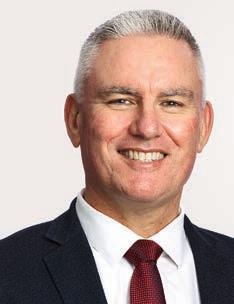




CorrosionX is a super fast penetrant on corroded parts. On reassembly it acts as long-lasting protection and stops electrolysis.
CorrosionX proudly supplying New Zealand’s farmers on a daily basis.

CorrosionX waterproofs old and new electronics/ electrics in all machinery, trucks and installations. Safe on rubber, insulation,neoprene and all plastics. Safe to 39,000V.

CorrosionX Heavy Duty forms a dripless, dynamic,







self-healing film that stubbornly resists

 by Paul Campbell
by Paul Campbell
From farmers eager to get their annual rural event
There’s to be the added spice, of course, of all the fun of the fair for families, with top entertainment, exotic food and beverages, new products on offer and a great way to welcome in the summer and festive season.
As New Zealand and the world begin to look back on the stresses of the pandemic with its opening borders and dropped gathering restrictions, the New Zealand National Fieldays Society is on track to open from Wednesday, November 30, to Saturday, December 3.

The event was scheduled to run in June. CEO Peter Nation says the new dates this year ensure the Fieldays operate to its full potential. Around 13,000 contractors come and go in the lead-up to the event, building the small city that is Fieldays, which was not possible under the red traffic light setting.
“Our aim is to run a safe, secure, and successful event, ensuring Kiwis can come together and reconnect, enjoying the best of what Aotearoa’s primary sector has to offer,” he says.

Based on a 114-hectare site at Mystery Creek, 10 minutes from Hamilton, it’s the largest agricultural event in the Southern Hemisphere. On-site this year will be the
Innovation Awards, a launch platform for primary Innovation with a total prize package of more than $60,000 worth of cash, services and products.
Visitors turn out in record numbers for Fieldays at Mystery Creek on board this year, to expand the potential opportunities for our prize winners.”
Programme developer Steve Chappell says the prizes are designed to help innovators to accelerate the growth of their products. “We are thankful to our returning sponsors for their continued support of the awards and new sponsors
Full details of the prize package for each category can be found on the event’s website, where expressions of interest are now open for the 2023 competition.

Fieldays is also partnering with the Ministry for Primary Industries (MPI) to launch a careers opportunity, which will showcase the food and fibre sector, sitting
under a strategic event pillar of education, for attendees to learn about food and fibre career pathways and consider joining a thriving sector.
MPI’s director says primary industries have grown despite the Covid-19 pandemic. “New Zealand’s food and fibre sector is leading the nation’s recovery from Covid-19 by keeping vital food and fibre flowing domestically and overseas. For the first time, annual export revenue reached more than $52.2 billion in the year to 30 June 2022.
“With such a key sector contributing to the New Zealand economy and the wellbeing of our rural communities, it’s important we have the necessary workforce to meet the demand,” says Ray Smith.
“There are rewarding, life-long careers available in food and fibre right across the supply chain, ranging from work onfarm, in science, technology, business management and logistics, to animal welfare, marketing, and research and development in locations across the country.”
Tickets are available online, ranging from adults valid for one day at $30 and child at $15 to a four-day adult pass at $100 and a one-day family pass at $90.



Since the advent of the National Field Days, innovation has been a frontrunner for ingenuity aiming to benefit the primary industry and solve rural issues.


The Fieldays hope to address issues on the farm and encourage those with solutions in mind. There are four awards competitors can aim for; the Growth and Scale Award, Early-Stage Award and the Prototype Award. There is an additional prize for the Young Innovator of the Year. This award is for entrants under 25 years old.
All ideas had to solve a problem in agriculture, forestry, horticulture, viticulture or the seafood industry. Applications for this year’s awards closed on October 6. However, ingenuity is encouraged year-round, and entries remain open for 2023. So if you have a groundbreaking idea, take the opportunity to apply as a contestant for next year.
It is a chance for competitors to win network opportunities with those who reign supreme, prized with money and other aids to help push their ideas forward. Young Innovator of the Year winners receives $1,000 each from Fieldays and Soda Inc totalling $2,000. All other awards give champions $10,000 and additional opportunities for their designs.
Judges will assess what ideas fit the various criteria that look at innovation, marketing promise, business plans, health and safety and the teams or founders.
This year’s judges are Andre Wisse, Jacqueline Rowarth, Peter Dowd, Professor Tony Parker, Gil Meron, Craig Watkinson, Craig Purcell, Jason Tuck, Brendon O’Connell, Shane Dooley, Jonathan Prince, Andrew Cooke, Stephen Hoffman, Lloyd Brownlie and Don Gray.
Previous Fieldays have seen success for smart ideas that benefit various areas of the primary industry locally and abroad. Springarm won the Innovation Prototype Award. It is a flexible trough ballcock arm that has been deemed unbreakable, allowing farmers to spend less on replacing parts. Ric Awburn designed the i nnovation.
The Early Stage Award and Young Innovator of the Year went to Cropsy Technologies. Five young minds collaborated to invent a camera attachment for tractors that could identify vines for disease.
The Growth and Scale Award prize went to Intelligent Growth Solutions, from Scotland and the US. It was a sustainable innovation offering maximal quality and quantity to farmers with the benefit of cutting the costs of energy by 50 per cent and labour by 80 per cent.

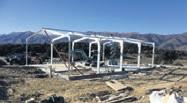


The time to witness possible future solutions in agriculture is approaching. This year’s anticipated event after it was postponed earlier this year. Fieldays starts on November 30 and ends on December 3 at the Mystery Creek Events Centre, 125 Mystery Creek Road, Ōhaupō, Waikato.

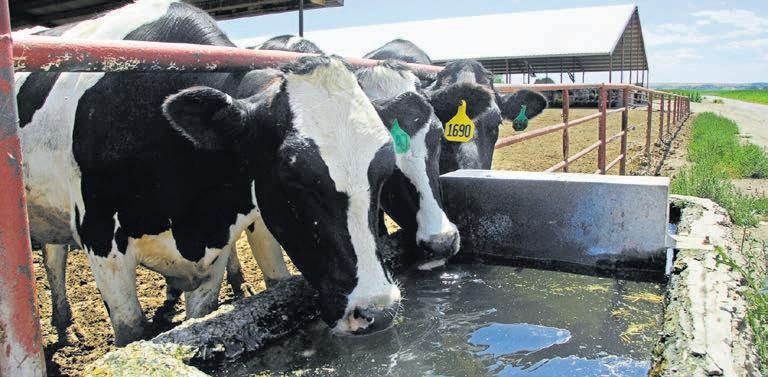
Machinery is family-owned Kiwi business providing forklift solutions to New Zealanders


We specialise in rough terrain 4x4 and all terrain diff lock forklifts for all markets across



Zealand.

“It is a chance for competitors to win network opportunities.”
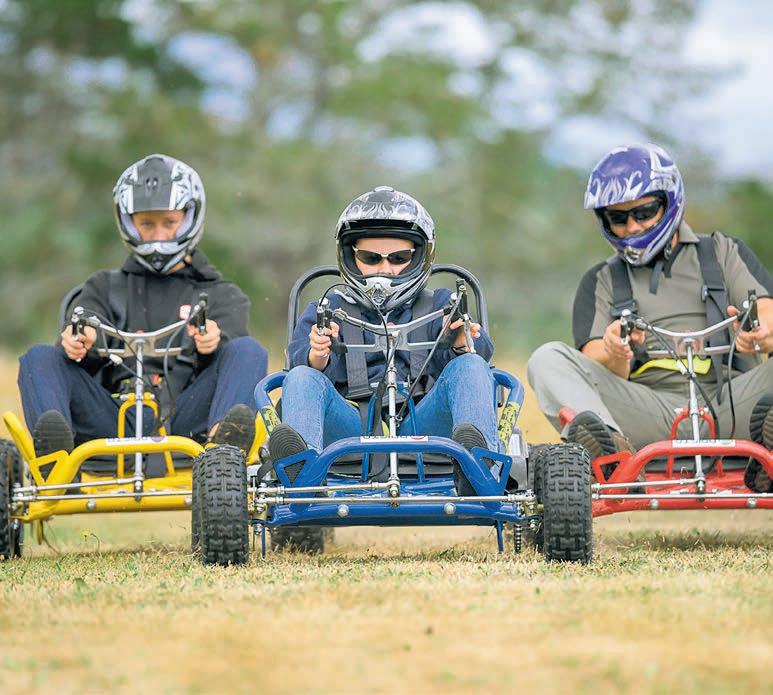
Go Karts Direct is an exclusive importer and distributor of go-karts for the New Zealand market.



Having established a reputation for quality drift go-karts, the Drifta brand has been developed to include 10 different models, including single-seater and double-seater karts.
Fun for all ages, our single-seater drifta karts are ideal for lifestyle blocks, farms, orchards, paddocks, elds, and reserves. They are safe and easy to operate, having a low centre of gravity

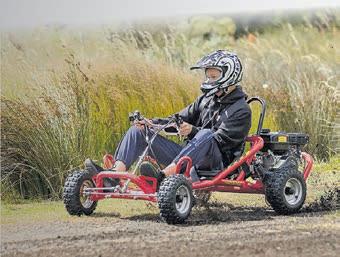
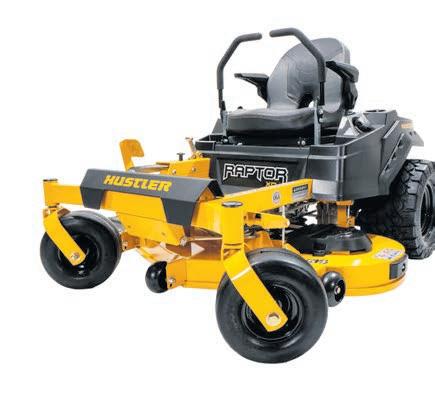




Go Karts Direct supplies go-karts for all ages nationwide

— their design enables them to drift rather than roll.

They are a great way to learn driving skills, gain con dence and have lots of fun!
The team at Go Karts Direct pride themselves on offering friendly and professional service, with backup support and technical advice. Our full range of spare parts is also ideal for building your own kart or other DIY projects.
The Go Karts come pre-assembled in a box, and we can freight to main centres anywhere in New Zealand.
We offer affordable products, so children and adults can have hours of enjoyment and outdoor fun.


By eliminating high overheads and retail mark-ups, we pass the savings on to our customers. For more information, photos and video — visit gokartsdirect.co.nz.


If you have corrosion problems, Prolan provides a solution;





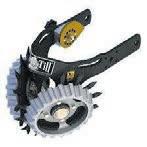

environmentally friendly lubricant and corrosion inhibitor made




in New Zealand from lanolin.

Prolan lanolin lubricants and grease lubes have a natural af nity for all metal surfaces. Once applied, it will stay on for long periods by forming a natural barrier that prevents corrosive agents from penetrating the surface.
The application of a Prolan coating can protect your vehicle chassis from rust long-term. This coating will help vehicles pass their annual WOF or COF as it stops rust forming and is recommended by vehicle testing centres. The product is being used to prevent corrosion on 4WD chassis, motorhomes, quadbikes, boat trailers and fertiliser spreaders.

A quad bike running on a dairy farm with no corrosion protection can rust out within three years if it is not continually maintained. Once purchasing a vehicle or quad bike, the best treatment you can give the chassis is a coating of Prolan. With regular coatings, the chassis will still be in excellent condition years later, increasing the resale value and making maintenance easier.


After a coating of Prolan, it is easier to remove dirt and mud off your chassis; even cold water blasting will not remove the coating. The coating is also

safe on rubbers and wiring. Minimal preparation is required for the surface to be coated. If there is existing rust, Prolan can be applied, and will stop any further corrosion.
Prolan’s unique, versatile products are made in New Zealand and exported to Europe. It is used in some of the toughest and coldest environments, protecting machinery, vehicles and even wind turbines. With a growing trend for environmental friendliness and biodegradable products, Prolan ticks all the boxes — Prolan is safe to use and easy on the environment.
Prolan has an increasing number of retail outlets stocking its products throughout NZ. Check out the website prolan.co.nz or Facebook Prolan New Zealand or call 0800 PROLAN (0800 776 526). Visit us at the Mystery Creek Fieldays — Site F11/F11A.
“Prolan’s unique, versatile products are made in New Zealand and exported to Europe.”
 by Amy Fifita
by Amy Fifita
The Bay of Islands Pastoral and Industrial Show

on Friday, November 11



event officially starts at 10am,
be open from 8am.
us
the 205 Showgrounds
children 12 years and under free but must be supervised by an adult. Free parking is available and dogs are restricted from entering the showgrounds. It is a familyfriendly environment.
It can be enjoyed by children and adults alike. So make it a family day out exploring the benefits of primary industries and all it entails.
There will be live entertainment and more, with plenty of food to delight in the Source Food and Wine Festival included in the event. The day seeks to give a space for event-goers to connect with people in the field, learn and watch various competitions, exhibits, demonstrations and traditional events.
Amongst the competitions will be livestock sections showcasing calf club, pet lambs and sheep dog trials. There are various equestrian sections for horses, ponies and miniature horses where attendees can view showjumping, hack ring events and much more.
For those wanting to see something more craft-based, there will be floral art

displays in the hall exhibits. There are also baking, pickling and produce competitions for judges to award prizes, trophies, cups and medals too.
Also in the hall exhibition will be home brew for more than alcohol but cordial and ginger beers as well. There will be displays of Māori crafts, plants, woodwork, roses, needlework, sewing and photography to view.
There will be a chance to enter the gumboot throw, which is part of Harcourts’ involvement to raise awareness and money for youth mental health. You can sign up at the gate for a chance to win in one of the sections or the open section event.

The Waimate North location has been home to the event since 1888. The show can boast being the first agricultural show starting in 1942, and this year marks its 180th anniversary. It started as an agricultural demonstration and, in the past, has merged with other shows.
It is a short drive from Kerikeri and is located rurally, which will add to the atmosphere of the event. Past events have seen about 7,000 visitors engage in the event. The show will be a chance to take the family out for an occasion that covers various events, from homebrewing to animals.


Aerial topdressing has strong roots in New Zealand agriculture, although its modern use started in the USA in the mid-1920s.

The first known aerial application in New Zealand was in 1906. However, it was not in an aeroplane. John Chaytor took flight in a mobile tethered hot air balloon in Wairau, Marlborough and threw seed upon his Marshlands family farm. Following his death in 1920, his son, Edward Chaytor, continued the idea.
In the US, in 1921, John Macready piloted USAAC Curtiss JN4 to spread lead arsenate in Ohio to eliminate Catalpa sphinx caterpillars. Later, in 1924 the US attempted to commercialise aerial topdressing for insecticides and fungicides.
In 1926 the idea was suggested separately by Len Daniell from Wairere and John Lambert from Hunterville. Len indicated his interest in aerial topdressing to the government, then wrote to Henry Ford in the US asking him to consider designing a suitable aeroplane. John wrote to his local MP.
It wasn’t until 1941, that New Zealand saw the fruition of the idea. Alan Prichard sowed lupin seeds from his aircraft by throwing them out the window of his plane over Ninety Mile Beach, Northland.
Technically, dropping anything from an aeroplane was considered illegal until 1947, when the government allowed test aerial sowing at Ōmarama in the Mackenzie Basin.
The first official trials happened in 1948 at Ōhakea using a New Zealand Air Force Grumman Avenger. It spread fertiliser, and the results showed that granular fertiliser was best applied using this technique.
Further trials were done using the Grumman Avenger in Waikato, with disappointing results from superphosphate becoming compacted from airframe vibration. The flowrestricting effect was stymied when they used granular fertiliser.
In 1949 lime application also showed the same restriction the Waikato trial had seen. It was temporarily solved by adding superphosphate to the hoppers first to promote flow. With trials showing promise for aerial topdressing, the government handed the development to commercial operators to continue.
In developing the idea, aerodromes were cast aside, and airstrips or flat areas



were favoured for landing. Trucks would follow the aircraft to make refilling easier and minimised time greatly.
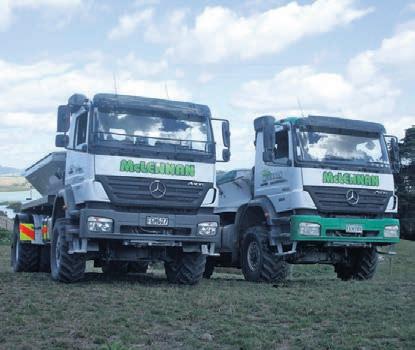
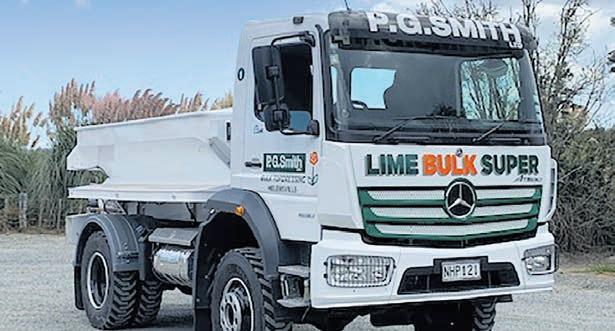

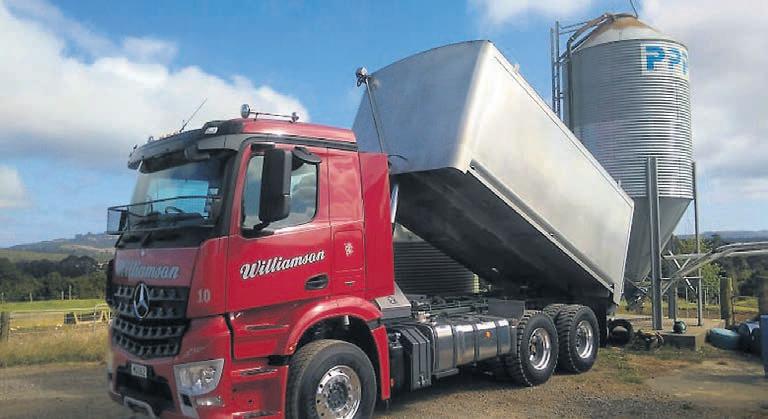
The post-second world war timing was an advantage. Many men returning from the war could pilot the aeroplanes. There was a surplus of De Havilland Tiger Moths, used for training, which could carry a fertiliser load of 272 kilograms. In time other aircraft, such as the Piper Cub, would be used.

The first companies in 1949 to offer this service were Gisborne Aerial Topdressing, Airwork, James Aviation and Southern Scenic Airstrips.
The horizons broadened. By 1952, the Civil Aviation Department created safety specifications for aerial topdressing to adhere to. In 1958 New Zealand had 73 commercial companies offering aerial topdressing, a cheaper alternative to doing it by hand.








 by Amy Fifita
by Amy Fifita
Soil is a living system of its own. Take care of it by preventing soil compaction; hopefully, it will reward you with a good yield.
Soil compaction happens when pressure is applied to the ground damaging the soil structure and particles. The effect creates density and an absence of air pockets. On top, water cannot go through the soil, and the land is unusable.
You can prevent soil compaction with tillage techniques to restore and maintain your soil to a healthy level. The use of subsoilers and rippers can help. The benefit of tillage techniques is that it will rid the land of weeds and promote water, light and nutrients. Modern tool designs are specifically engineered to offer alleviation to compacted soils.
Robust subsoilers should restore the affected ground to workable conditions and can be used for long-term soil compaction areas. Make sure it works to a critical length, so the soil is better prepared.
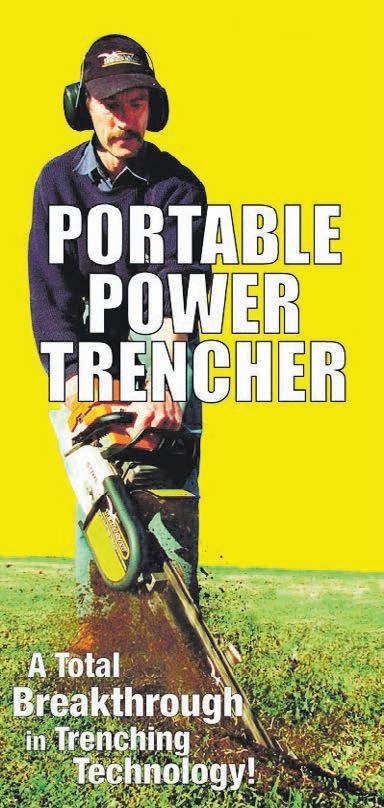



The problem with using machines for tillage is it can increase soil compaction. Four-wheel drives cause less compaction than the two-wheel drive alternative because weight is more evenly distributed.

There are ways to reduce this effect, and various companies are working on how to best design tracks and tyres to decrease soil compaction and disturbance. Control traffic on your property to reduce soil compaction. It can be achieved in various ways, from low-till and no-till methods, by only tilling what is necessary.



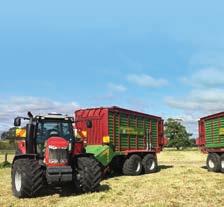


Low-till involves drilling seeds into the land. It reduces erosion, improves water penetration depth and promotes organic matter to remain.
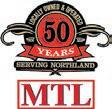



No-till methods only till the surrounding seed trench. and tilling ceases from there. This technique is cost-effective, so you won’t have to pay out as much on running your tractor. It also shows positive results within two to five years, according to some studies. Biomass is further promoted, adding nutrients to your soil.


 by Andy Bryenton
by Andy Bryenton
Henry Ford famously replaced the horse as a means of on-road transport by introducing the affordable Model T. Still, it wasn’t until 1982 that the farmer found a better way to tackle tough terrain.
The quad bike is 40 this year, and it’s come a long way since its introduction way back in the era of denim on denim and big moustaches. However, it was a torturous path through some hit-and-miss ideas which led to the quad layout becoming so successful.
It all began back in 1893 with a brand that’s still around today. Royal Enfield created a quadricycle, or four-wheeled motorbike, back when Queen Victoria was still in charge and gentlemen dressed like Sherlock Holmes. It was meant to replace light horsedrawn buggies of the kind the Amish people of Pennsylvania still utilise, but it never took off, and Enfield went back to bikes.
During the second world war, bikes were popular for speeding messages to the front, sidecar-mounted machine guns were a strategic asset, and the king of the battlefield was the tank. Combining all the worst properties of all three, the German Sonderkraftfahrzeug was an odd attempt to solve the problem quad bikes would handle many decades later. Steering with handlebars but driven by tracks like those of a Panzer, the machine had
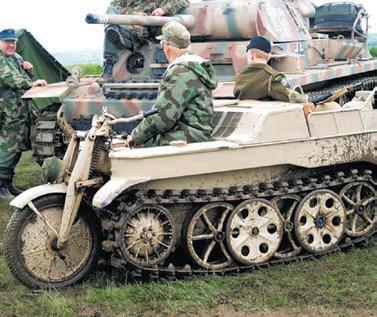
neither the nippy speed of a bike nor the oomph of a battle tank. Also, the name was impossible to pronounce.


Things were quiet for a time until an unassuming Japanese auto engineer from Honda, Osamu Takeuchi, was given a very open-ended design brief by his bosses. ‘Make us something that uses a motorcycle engine but will sell well in winter’, they told him and he obliged.

Honda’s chief Soichiro was perhaps expecting a snowmobile, but instead he got the ATC90, a balloon-wheeled trike with a seven-horsepower engine and a tiny price tag of $600 at the time. Honda dealers in the US sold them as fast as they could get them, mainly for recreation, although farmers in other parts of the world where the mud was a winter problem took note. Some of those farmers were New Zealanders.
Suzuki came to the Kiwi backcountry to develop a new project in the early 1980s, an attempt to make a safer, more stable off-road bike. They avoided the German idea of treads, added one more wheel, then put the resulting machine through

During the years, many tried to come up with a way to make a motorcycle work in truly rugged terrain; the Germans did not really nail it during the 1940s
its paces. Thus the QaudRunner LT125 was born, and the rest is history.
Other companies, seeing the utility and practicality of the basic idea, all put their own spin on the quad concept. They developed memorable names of their own, engaging in a war of horsepower and safety, grip and torque that has greatly benefitted the Kiwi farmer. Cheers to 40 great years, quad bikes! Who knows how they will evolve next?
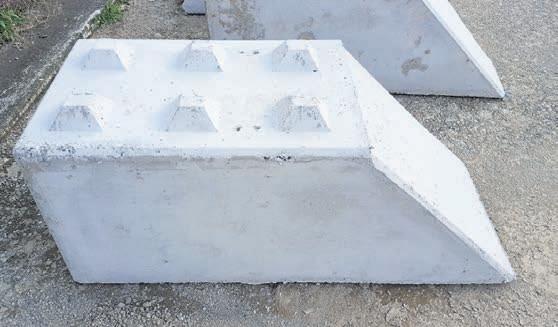
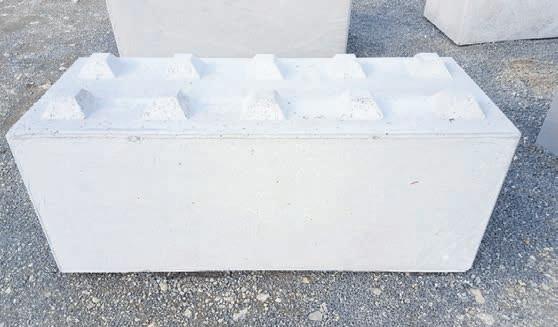

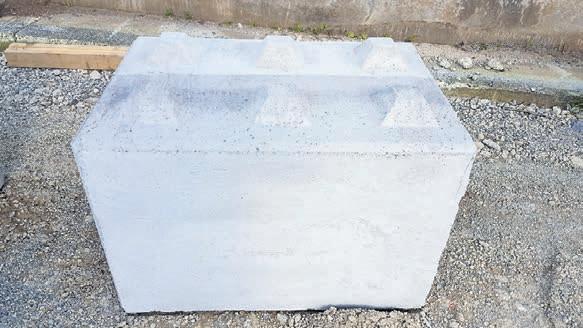



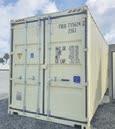
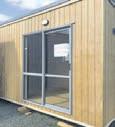


Over-regulation of the rural industry is a contentious point across the nation, but how can a smart local council balance Wellington’s lawmaking with practical solutions that aren’t arduous to farmers?

It’s a matter of bridging the gap between theory and application, says Richard Alspach, who has a background in farming and local governance.
“A smart council would administer governmental legislation like the Resource Management Act’s successor, and their own District Plan, more as a door than a wall,” he says. “Councils are closer to the people affected than the government, and the way they apply the rules makes a huge difference.

“The issue is that Wellington-sourced solutions to rural problems often come from the realm of pure theory. They work on paper but not in practice. By comparison, many fit-for-purpose systems in the farming world evolved from the ground up, in ways that seem odd in theory but work very well in practice,” says Richard.
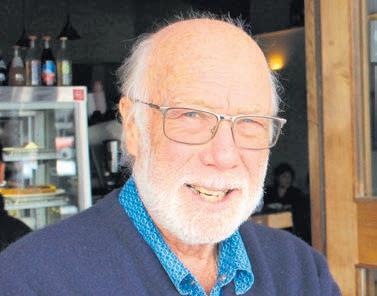
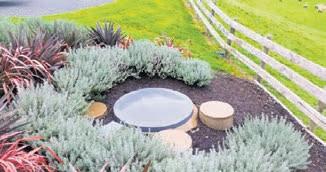
Significant Natural Areas or SNAs are a case in point. On the ground, farmers have often preserved native bush, wetlands and other natural areas out of genuine environmental respect and because such areas do not make good crop and pasture land. There’s simply no will to damage them, and when such areas were mapped before, in the 1990s, very few were found to have been damaged.
A practical approach would be for councils to talk to farmers about not having to pay rates on parts of their land sectioned off for environmental protection and reach a compromise. However, a theoretical, authoritarian top-down approach has only brought antagonism and protest.

“Similarly, a smart council could pick on a core issue, carbon afforestation, and safeguard productive land by allowing the planting of carbon forests only on hilly, marginal terrain,” says Richard. “Wellington’s rules about carbon would be followed, but the huge asset which is our productive land would be safeguarded.”





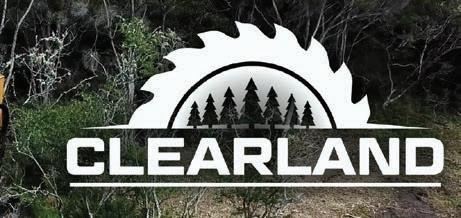






















































The rst ever lawn mower, built in the 1830s, was made of cast iron and was so heavy you needed two people to operate it: a pusher and a puller.
Since then, all sorts of mowers have been developed, from animal-drawn mowers and steam mowers to the push mowers and ride-ons we see today. Still, let’s face it, for free-time-loving people everywhere, and that’s practically everyone, the most exciting development in mower technology EVER has to be the robot mower.
Surprisingly, robot mowers have been around for a good 30 years now, although they only became more widely available in the mid-2000s. The technology robot mowers use now is pretty impressive, and it will only get better in the coming years.


Most residential models operate from a docking station via WiFi, with guide wires placed along property boundaries (preferably underground) de ning the mowing area. Driveways are a breeze for these clever little bots. The guide wire technology allows them to cross up to three metres without cutting and then resume mowing on the other side.
The units travel in a continuous zigzag pattern allowing them to handle your curves expertly. Setting options for how far they go past your guide
wire makes them incredibly accurate at cutting edges. They only need a space of around a metre wide to operate, and they can handle slopes up to about 23°.

With recent advances in technology, Husqvarna has now brought out a higher-end model that operates via a smartphone app, recording every move your robot mower makes. This all-wheel, articulated model can also turn around faster and handle much higher degree slopes, making this great for around the house or on a lifestyle block.





The next big step for robot mowers is moving away from guide wires to operating via GPS. This technology
is already in production for larger commercial models. However, it will be a while yet before you can buy a model like this for use in your backyard.
It’s true the outlay for a robot mower may be a bit of an investment. Still, once you’ve purchased the unit and had the guide wires put in, ongoing costs are a fraction of what it takes to run a standard lawn mower. You’re not buying petrol, new blades are only around $30 every six months, and YOU DON’T HAVE TO MOW YOUR LAWN ANYMORE.
Check out the range available at Gatmans Mowers & More.















Fundraising efforts for Northland Rescue Helicopter are underway again with the launch of the 2022 annual appeal.
CEO Craig Gibbons says the next three months will be an exciting time for the air ambulance service. Its fundraising team aims to attract more than $300,000 in public donations for the third consecutive year.
“We are always so appreciative of the generosity of people in Northland with their support of the work we do,” says Mr Gibbons.
“Our team is very aware of, and grateful for, the fundraising efforts that are done on our behalf throughout the year. They are part of the community too, and are really proud to be a part of the annual appeal.
“The same goes for Northpower and Top Energy for their fantastic ongoing sponsorship. They have been on board with us since day one, back in 1988, and we really appreciate their backing and passion for our cause.”








Top Energy CEO Russell Shaw says the reason for sponsoring Northland Rescue Helicopter is simple.
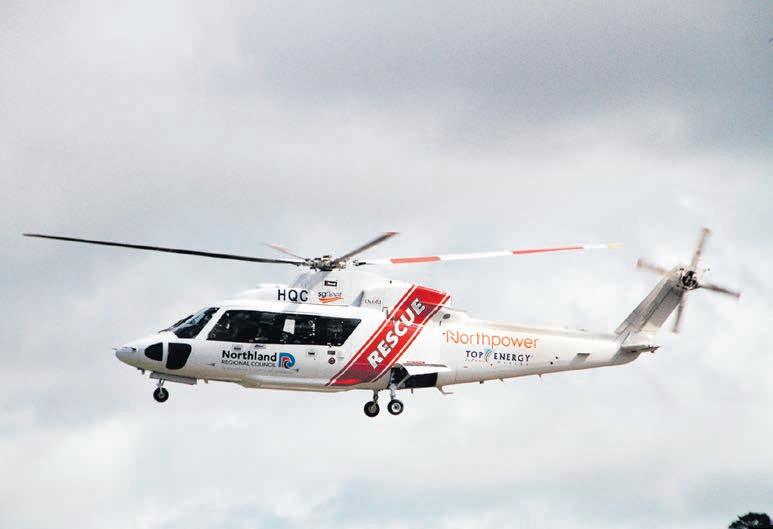

“We support the cause because the service saves lives — lots of lives,” says Mr Shaw.
“Everyone in Northland knows someone who has been helped by one of these
choppers, and that’s why there is so much community support. Top Energy staff have had their lives saved by this service, and that is the case for Northpower too, so I encourage people to get in behind the 2022 appeal and donate what they can.”
Andrew McLeod, Northpower’s CEO, says like Top Energy, the company remains committed to the service.
“It is a world-class operation, and it is here for us all 24/7. It is just so critical for keeping our community safe,” says Mr McLeod.
The Northland Rescue Helicopter provides vital life-saving services to rural communities
“Northpower staff are really proud to be aligned with our rescue helicopters. The crews do a great job for the people of Northland,
Northland Rescue Helicopter flies around 1,200 missions




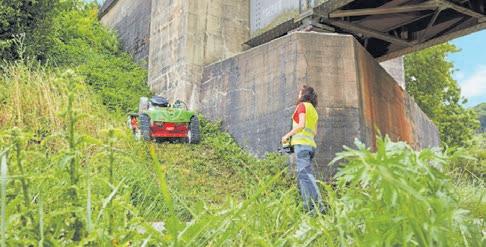
year. People can donate at nest.org.nz/donate. Follow the


annual appeal








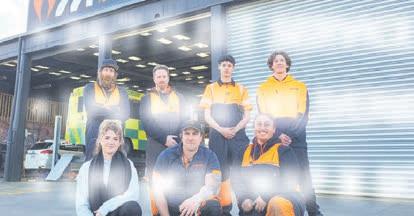








prestigious
industry encouraged to





Held annually, over a three-year cycle, the award covers dairy, sheep and beef and horticulture, with the inaugural competition for horticulture held in 2020.

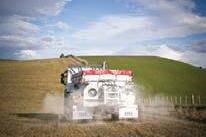

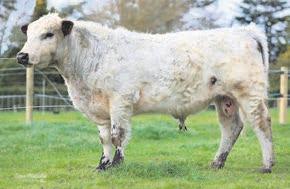

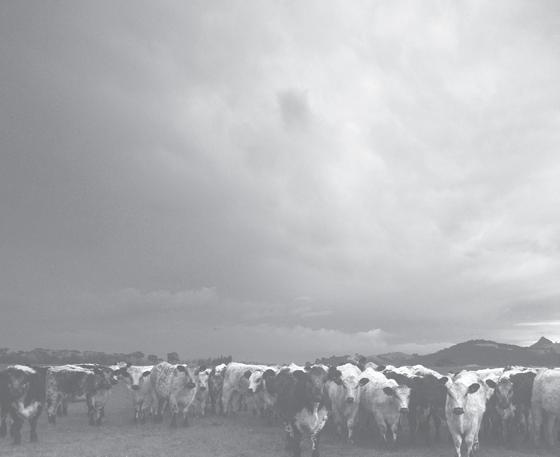
The competition objective is to recognise excellence in Māori horticulture and is open to individual Māori running horticultural operations and other entities such as Māori trusts and incorporations.

“What a great privilege it is for the horticulture industry to be associated with the Ahuwhenua Trophy and showcase the tremendous mahi that Māori are doing to further our industry, as well as their own iwi and whānau,” said Barry O’Neil.
“The inaugural 2020 horticulture competition highlighted an intrinsic commitment to the whenua (land), awa (river) and people. I look forward to the coming year as, once again, we work together to promote passion and good practice, as the kaitiaki of Aotearoa.”
Ahuwhenua Trophy management committee chair Nukuhia Hadfield says, “in the past decade more Māori have become major investors in the sector and this has resulted in good financial returns and jobs for our people.
“However, there is still much more to do, and I am sure with the positive publicity that the Ahuwhenua Trophy competition generates, this will encourage more Māori to become involved in the sector.”

“In all the major horticultural areas around the country, there is clear evidence that Māori are setting up new horticultural businesses or further developing established ones and are major contributors to a sector which in the past year earned $6.5 billion for the economy of Aotearoa New Zealand.
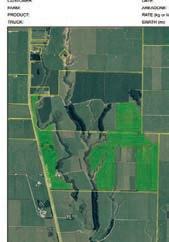
“I now urge all those Māori enterprises to take the next step and showcase their operations to Aotearoa by entering this competition. It is a unique opportunity to demonstrate the innovation and quality, along with genuine sustainability, which sits behind our horticultural businesses.
with people of Māori descent in the




Plant & Food Research, Zespri, Ballance Agri-Nutrients, Fruitfed Supplies, BDO, FMG, Massey University, New Zealand Fruitgrowers Charitable Trust and Kono Wines.


Te Puni Kōkiri, Primary ITO, Te Tumu Paeroa and Horticulture New Zealand sponsor the Ahuwhenua Young Māori Grower Award.
“For the finalists, there is not only the prestige of winning the competition but the added benefits of high-quality feedback they receive on their enterprises.”
Entry details can be found at ahuwhenuatrophy.maori.nz. Entries close Friday, December 9, and the finalists will be announced in February 2023. Field days will be held in April/May, and the winner will be announced in June.

The Ahuwhenua Trophy is sponsored by Te Puni Kōkiri, the Ministry for Primary Industries, Te Tumu Paeroa, BNZ, NZ Māori Tourism, Horticulture New Zealand,



Last month, Northland Road Policing
This month, I am touching on another vital safety aspect of our daily lives.
I have been really disappointed to observe some opposition to the Northland Rescue Helicopter relocation to Onerahi Airport — from a minority of the community, I must say.
As I write this column, I can hear one of our life-saving choppers in the air and every time I hear or see them in action, I feel for the families of those in need. I lived next to the Kensington hangar and didn’t notice the choppers after two

days. It is such a critical (and charitable) community asset that saves lives 24/7.
If you have a coronary or neurological episode, you are closer to Auckland Hospital than an Aucklander.
So, for anyone to oppose the location of a rescue helicopter service is beyond me. It must be somewhere, and if that causes inconvenience for some people at times, I feel that is a small price to pay for having a life-saving air ambulance service here for us — day and night.
Town or country, the Northland Rescue Helicopters are there for us all. They don’t discriminate. They save lives and get people to safety day in, day out. The pilots and paramedics provide us with amazing levels of care.
I know many people helped by our choppers, and they are forever grateful. Survival is often down to getting help to the injured or ill in the ‘golden hour’. It means our fellow Northlanders have the same critical medical care as those living in Whangārei.
That’s why our Northland Rescue Helicopters are so critical to the wellbeing of Northlanders and anyone travelling in the region because of our vast land mass and coastline.
They will get to us and get us to the hospital much quicker than ambulances and that is often the difference between life and death. I am aware of a young farmer near Paparoa who went to

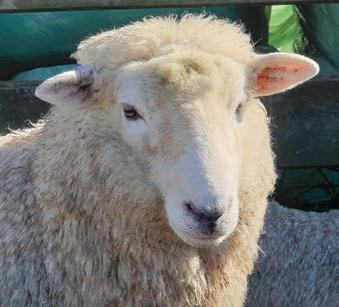






Whangārei to see an eye specialist because he had blurred vision. The Rescue Chopper immediately flew him to the neurology department in Auckland and saved his life.
It is commonly said that you just never know when you may need a Northland Rescue Helicopter to help you, a loved one or a workmate.
Local farmers who have suffered injuries or illness in often remote areas appreciate how vital it is. I guarantee our choppers have helped thousands of farmers and their family members over the years.
The Northland Rescue Helicopter service has been nothing but transparent about the need to move to Onerahi because it has outgrown its Kensington base, can’t find a more suitable location and because its lease is coming to an end.
Furthermore, taking off and landing over a public park, and next to State Highway 1 is not ideal.
So, let’s all get behind Northland Rescue Helicopter and help make its must-needed move to Onerahi Airport.
To me, all of my farming colleagues and many of our urban-located friends throughout the north, having a rescue helicopter service based at an airport and in close proximity to the largest hospital in Northland is nothing but common sense and the best solution for us all.
Please don’t stand in the way of someone’s life.
Stop


hens’

weather proof,
no food
















Heavy is the head that wears the crown,
There’s an exception to every rule, however. While some might opine that Elvis is the exception to this one, a better example is found in Suzuki’s ATV line-up. The Kingquad has been waving the sceptre as Suzuki’s flagship offroad machine for many years now. Rather than diminishing with age, the brand just keeps getting better, with small improvements to each generation.
Take the 2022 Kingquad 500XP, for example. Yes, it’s built on the same no-nonsense platform as its illustrious predecessors. If the formula works, why change it drastically? Four decades of feedback on stability and handling have been packed down into this big red machine. However, there have been some improvements, as told by the gures.
Start with frame tubing that’s 25 per cent thicker for more stiffness, rigidity and more ability to handle punishment from nature. Then add a towing capacity bumped up to 600kg, extended suspension travel on the independent suspension for all four wheels, and bigger brakes, and the picture begins to emerge. Power is delivered by a four-stroke, liquid-cooled 493cc Suzuki engine, with internal tech informed by years
to stay at the top when you’ve been given the title of king.

Suzuki’s big Kingquad 500XP and its variants carry on a 40-year tradition, getting better every year

of building bikes that win races and quads that work hard.
The Kingquad’s instrument cluster has been upgraded to be easier to read.
At the same time, the power steering system on the 500XP is more responsive than ever, making for an easier day in the saddle. A smoother CVT gearbox
delivers horsepower to the ground with no need for gear changes.


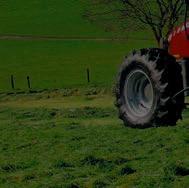




Suzuki got the whole ATV game started here in New Zealand back in 1982 when the mullet haircut was new, and Eye of the Tiger from Rocky was the number one pop song. From the LT125 of those days to the big Kingquads of the present, Suzuki’s story is one of constant and incremental innovation, adding new features and upgrading power and comfort with each new model. Give one a test ride this spring and nd out why so many farmers say ‘hail to the king.’

“The instrumentKingquad’s cluster has been upgraded to beeasier to read. At the same time, the power steering system onthe 500XP is more responsive than ever, making for an easier day in the saddle.”
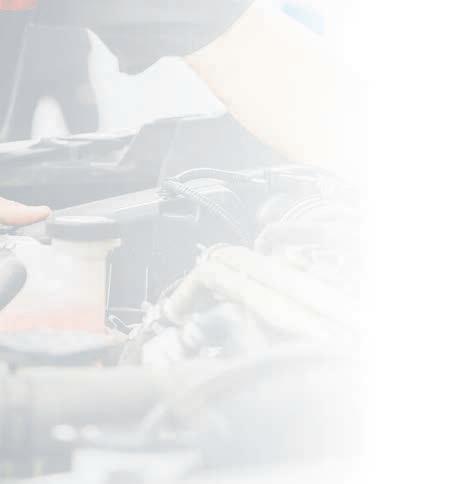
 by Amy Fifita
by Amy Fifita
remember travelling days in the 70s,
probably remember



Holden HK and HQ range of sedans and station wagons.

Often a beach hop choice, these iconic classics would have been seen along Uretiti, Muriwai and Ripiro Beach. Maybe, your destination was the snowy slopes, and filling up your Holden station wagon. Whatever your destination, you could pack up your mates or family, bags and gear in hand and travel.

The Holden HK was produced in Australia starting in January 1968; it was short-lived and ended production a year later in 1969. Its range was initially featured in the Belmont, Kingswood and Premier sedans and station wagons.
March 1968 saw the range extended into the Belmont and Kingswood utility vehicles and the Belmont panel van. By July 1968, the luxury model Brougham sedan was adopted into the bunch along with the Monaro coupes. The HK was succeeded by the HT range and the HG before the HQ range arrived.

The HQ was the second full redesign since Holden’s first vehicle the 48-215, unofficially named the FX. Production started in 1971 ending in 1974, but was developed into the HJ, HX, HZ and the final 1984 WB series.
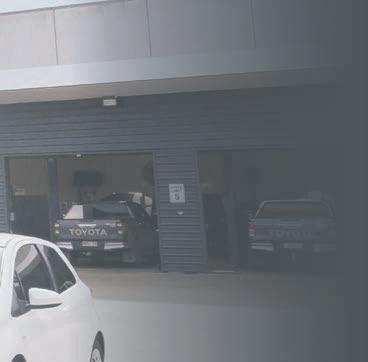
Like the HK, this range was for the Belmont, Kingswood sedans and station wagons and the Monaro coupe. The Monaro had two GTS sedan additions
to its collection in March 1973. New in 1971, the cab chassis truck One Tonner was introduced in this range.
The Belmont HQ was a basic model. It had a two-toned door trim, a basic model and came with a three-speed manual column shift. The Holden SS also starred in this range as a limited-series model V8, first appearing in 1972 for those who enjoy the power a vehicle can have.
The middle-range Kingswood HQ offered a more stylish option for the exterior and interior with standard armrests and extra chrome on its body. The more luxurious HQ models were the Premier and Monaro GTS, which were similarly designed. The Monaro GTS showcased a stripe strip, unlike the other models.
They were the Australian muscle car with various options and models available. The HQ and HK were for families with limited means and those with ample money. Everybody could enjoy them, and they remain iconic today.


Perhaps a more beautiful sight than the 70s fashion of mismatched colours and bad haircuts, the Holden HQ and HK range remains a desirable classic. These cars are reminiscent of 70s camping and travelling, making them more than just a car, but a memory of earlier days.
